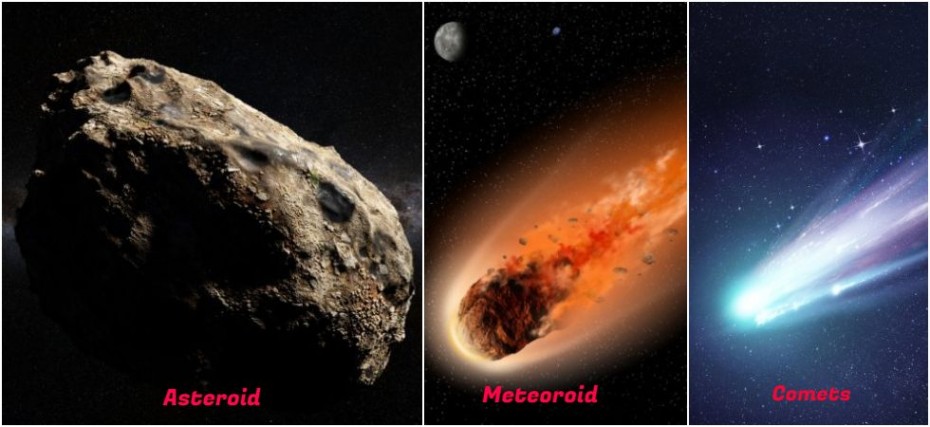For space enthusiasts, celestial bodies such as asteroids, meteors, and comets are a fascinating subject. While these three celestial bodies may seem similar at first glance, they are actually quite different in terms of their composition, size, and origin. Understanding the differences between these three celestial bodies can help us better understand our solar system and its evolution.
Asteroids are small, rocky celestial bodies that orbit the sun. They are typically found in the asteroid belt, a region located between the orbits of Mars and Jupiter. The asteroid belt is home to millions of asteroids that vary in size from a few meters to hundreds of kilometers in diameter. Asteroids are made up of a variety of materials, including metals, rock, and ice. They are believed to be remnants of the early solar system, formed when the solar system was still in its infancy. As such, they contain valuable information about the early solar system and the conditions that existed at the time.
Meteors, on the other hand, are small pieces of space debris that enter the Earth's atmosphere and burn up due to the friction caused by the Earth's atmosphere. When a meteor enters the Earth's atmosphere, it creates a bright streak of light that can be seen in the sky. This phenomenon is known as a meteor shower. Meteors can be made up of a variety of materials, including rock, metal, and ice. They are typically small, ranging in size from a few millimeters to a few meters in diameter. Despite their small size, they can be incredibly destructive, as they travel at high speeds and can create powerful shockwaves upon impact.
Comets, on the other hand, are small, icy celestial bodies that orbit the sun. Unlike asteroids, which are made up of rock and metal, comets are made up of ice, dust, and various other volatile materials. Comets are most often found in the outer reaches of the solar system, in a region known as the Oort Cloud. When a comet is pulled into the inner solar system by the sun's gravity, it begins to heat up and release gases and other volatile materials. This creates a bright, glowing coma around the nucleus of the comet, which is visible from Earth.
One of the most interesting things about comets is that they have a tail. As a comet gets closer to the sun, the heat causes the volatile materials in the comet to vaporize, creating a tail that can be millions of kilometers long. This tail is made up of gas and dust that is blown away from the comet by the solar wind.
One of the most obvious differences between these three groups is their size. Asteroids are typically the largest of the three, with some reaching hundreds of kilometers in diameter. In contrast, meteors are much smaller, ranging from a few millimeters to a few meters in diameter. Comets fall somewhere in between, with the vast majority being less than 10 kilometers in diameter.
Another important difference between these celestial bodies is their composition. Asteroids are made up of a variety of materials, including metals, rock, and ice. They are believed to be remnants of the early solar system and contain valuable information about the conditions that existed at the time.
Meteors, on the other hand, can be made up of a variety of materials including rock, metal, and ice. They are typically small and are formed when a small piece of space debris enters the Earth's atmosphere and burns up due to the friction caused by the Earth's atmosphere.
Comets are made up of ice, dust, and various other volatile materials. They are typically found in the outer reaches of the solar system, in a region known as the Oort Cloud, and are thought to be remnants of the early solar system. When a comet is pulled into the inner solar system by the sun's gravity, it begins to heat up and release gases and other volatile materials, creating a bright coma around its nucleus.
Another important difference between these celestial bodies is their orbit. Asteroids are found in the asteroid belt, a region of the solar system located between the orbits of Mars and Jupiter. There are millions of asteroids in the asteroid belt, ranging in size from a few meters to hundreds of kilometers in diameter.
Meteors, on the other hand, do not have a permanent orbit around the sun. They are formed when a small piece of space debris enters the Earth's atmosphere and burns up due to the friction caused by the Earth's atmosphere. While they may seem to be moving through the sky, they are actually falling toward the Earth at high speeds.
Comets, like asteroids, do have a permanent orbit around the sun. However, they are typically found in the outer reaches of the solar system, in a region known as the Oort Cloud. When a comet is pulled into the inner solar system by the sun's gravity, it begins to heat up and release gases and other volatile materials, creating a bright coma around its nucleus.

